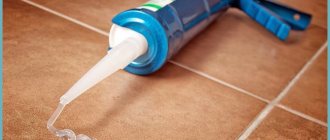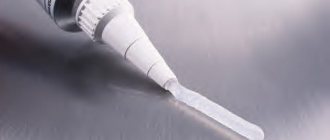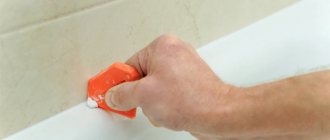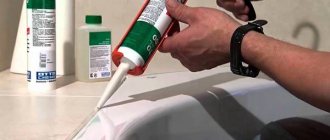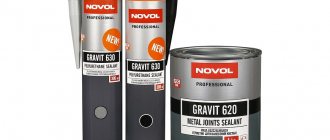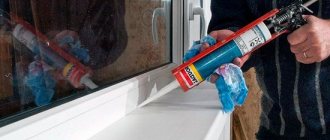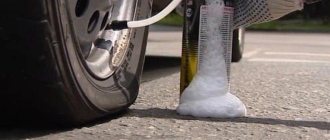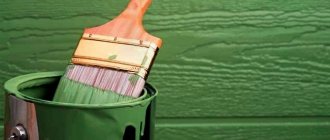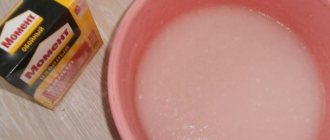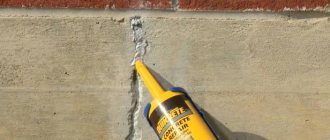General information
This is what silicone sealant might look like.
Silicone sealant is widely used when working with various objects and materials. In particular, they can seal plumbing fixtures, window frames, glass, mirrors and other types of finishing. Due to the presence of a number of properties, it can be called a universal remedy. It is worth highlighting the most important characteristics:
- elasticity;
- affordable price;
- ease of operation;
- moisture resistance;
- heat resistance;
- long service life.
Before you go shopping, you need to familiarize yourself with the other side of the process: how to remove the remaining sealant after work.
Manufacturers and professional craftsmen recommend choosing a method for removing sealant depending on its composition. Today, there are several main types of sealants: sanitary, aquarium, automotive, universal and others.
How to clean without damaging the surface
To avoid damaging the tile surface when removing hardened sealant, you should cover the area above the treated area with masking tape. When carrying out mechanical cleaning, it is necessary to avoid applying too much pressure on the tile with a sharp knife. You can wipe off the remaining substances in hard-to-reach places and on the surface using a knife or blade.
The procedure must be carried out as carefully as possible: this will help avoid scratches.
If silicone does not respond, it is best to treat the contaminated area with a chemical solvent and wait a while. This will slightly increase the cleaning time, but will also help protect the surface from damage.
Mechanical method
The most effective and simple solution is mechanical removal or the force method. The main purpose of this method is to damage the structure of the sealant. But if we are talking about removing residue from tiles, glass or mirrors, this is a bad idea. The process uses a pumice stone and a knife, so the finish may be scratched or damaged in appearance. It is most advisable to resort to a mechanical method when:
- there is no risk of scratches on the surface;
- it is possible to restore the integrity of the layer without difficulties;
- the sealant is removed in an area that will be hidden from prying eyes (behind the bathtub, appliances or furniture);
- the use of chemicals will cause great damage;
- appearance does not matter (basement).
Initially, you need to remove large pieces of silicone, and then move on to medium and small ones. After such actions, stains form. In most cases, you can get rid of them with simple dishwashing detergents and foam sponges. If the procedure does not give the desired result, it is worth exploring other methods.
The main tool for mechanical cleaning is a knife. To minimize deformation, choose a thin blade with a sharp tip.
Features of using silicone sealant
Silicone sealant is a material characterized by plasticity and the ability to polymerize. When exposed to oxygen, it turns from a viscous paste into a strong but elastic mass. In addition, this material is able to firmly adhere to any surface. These properties allow silicone to be used to fill even small gaps.
After hardening, the composition reliably protects the holes from moisture penetration into them. Once cured, a secure bond is created that allows the material to function but prevents it from being removed. To choose the best method for removing a sealant, you need to consider its type: neutral or acidic.
Both have their advantages and disadvantages. Acidic varieties of the material include silicone and vinegar, so when they harden they emit a characteristic odor.
The advantages of this material include:
- fast curing speed;
- low cost;
- high adhesion.
At the same time, such compositions do not combine well with cement coatings, metals and natural stone. Due to the rapid hardening during work, stains of the substance should be immediately removed from the tile if they accidentally get on it. After they harden, this will be extremely difficult to do - only with the help of a solvent.
Neutral materials are made based on amines and alcohols. They are safer and more expensive. At the same time, the polymerization process of such compositions proceeds quite slowly, but after hardening it creates stronger adhesion.
It is almost impossible to wash it off after it hardens. Thus, mechanical action is often required to remove a layer of substance.
Combined method
This method involves the use of both the method described above and chemicals. Let's take a closer look at how to clean surfaces from silicone sealant.
White Spirit
A rag or sponge is moistened in the solvent and used to treat a small area - white spirit evaporates fairly quickly. After just 30 seconds, the sealant seam should become soft and pliable, allowing you to carefully remove it with a knife or spatula. If the layer is too thick, the process must be repeated until completely clean. You can wash off any stains that have appeared with a solvent and then wipe dry with a soft, lint-free cloth or paper towel.
Acetone
The removal technology is the same as in the case described above. It is important to remember that acetone is quite aggressive in its composition. Therefore, before using it, it is necessary to ensure compatibility with the base material. For example, they cannot clean plastic, as the solvent will corrode the PVC. In addition, acetone easily penetrates the human body through the skin.
When using solvents, care must be taken to protect the respiratory system and skin of the hands. Use respirators and rubber gloves.
Salt
An additional method for removing a small layer or stain from a bathtub is to use table salt. The technology is quite simple: a tampon is made from a bandage or gauze, inside which a small amount of salt is placed. The swab is moistened in warm water and the desired area is wiped.
Heat
In order for the efficiency of the above processes to be several times higher, it is recommended, if possible, to preheat the surface. After the material has completely warmed up, you can even use household chemicals.
How to wash your hands
Silicone sealant is a popular way to seal tile seams, joints and cracks. However, in the humid environment of the bathroom, mold forms on the grout, which is impossible to clean off.
The process consists of the following steps:
- The maximum possible amount of old grout is removed mechanically. It is convenient to operate with a sharp object: a knife, screwdriver or scraper.
- Remains of destroyed silicone are removed with a vacuum cleaner.
- Then a special solvent is applied to the tile joints. The action time of the solvent is 2-10 hours. Specific deadlines are indicated on the solvent packaging.
- After the required time has passed, the paste is cleaned off with a soft cloth, and the seams are washed with soapy water.
- The prepared tile joints are filled with a new portion of silicone.
If the material has not yet hardened on your hands, then you need to take an ordinary small transparent bag or garbage bag and try to make the silicone stick to the cellophane. Afterwards, you need to carefully tear off the package along with the silicone.
For fairly old stains, take 2-3 tablespoons of table salt and dissolve it in 250 ml of water. Soak your hands in the resulting liquid for 11-16 minutes. A brush is then used to remove any remaining material from the skin.
If the above does not help, then you can heat any vegetable oil. Lubricate your hands with it and wait until a reaction with the silicone occurs. Afterwards, just wash your hands with soap, scrub or shower gel. It is important not to get burned when heating the oil.
It is better not to waste time during repairs on dealing with stains and sloppiness. It is better to prevent such contamination from occurring. Experts advise taking the following measures:
- use gloves;
- if the sealant drips or smears, immediately remove it with a rag soaked in vinegar;
- the label from the sealant bottle should not be thrown away, this will make it easier to select the required solvent at a hardware store;
- Masking tape will help to carefully seal the seams between two materials. The seams are perfect and even.
Specialized chemical solutions
Silicone cleaner
If there is no desire and time to remove old sealant from surfaces using the indicated methods, you can consider other options - special chemical solvents. They are sold in the same stores where the sealants themselves are sold. In addition, manufacturers have taken care to simplify the selection of the required type, and indicate on the label for which sealant the solvent can be used. They also differ in their consistency:
- pastes;
- foam;
- aerosols;
- solutions.
Sealant Remover
Instructions for use are indicated on each label. But in general, all actions can be described by a standard algorithm:
- Before use, clean the surface well and test the product on an inconspicuous area. This will let you know if the chemical will corrode the paint or enamel of the finishing material.
- When working, it is necessary to use gloves and respirators, as chemical solutions emit harmful vapors into the air.
- Once softened, the silicone is easily removed with a blade. After which you need to rinse the area well with water and detergent, and wipe with a clean cloth.
There are several common products used to remove sealant: Lugato, Penta-840, Dow Corning OS-2, and Silicon-Entferner.
Cleaning
You can quickly and without any consequences remove only the sealant that has not yet hardened and was recently applied. Therefore, if silicone gets on the floor, bathtub, sink, tiles or clothes, you can simply wipe it off with a regular rag or sponge. It is much more difficult to remove the sealant from the bathtub if it has already hardened.
The difficulty of removing hardened sealant depends on the type of surface and composition. The most difficult types of materials to clean are porous types of materials, such as cast iron, marble, enamel and concrete, as well as various textured surfaces, such as tiles or mosaics. If you correctly apply a high-quality type of sealant, then this composition adheres tightly to the surface, and it is very difficult to remove the sealant.
If you need to reapply the sealing compound, then the working surface must be cleaned of old material, this must be done carefully and efficiently. It is important to completely remove the old sealant, since fresh silicone adheres to old silicone very poorly. Therefore, if you remove the old sealant poorly, then most likely there will be a poor seal.
In order to remove the sealant that has managed to dry as efficiently as possible, both mechanical and chemical cleaning methods are used. In any case, it will not be possible to do this without applying physical effort, therefore, you need to start cleaning using the mechanical method. When removing old sealant using a tool, they try to slowly remove as thick a layer of silicone as possible, because chemicals dissolve a very small layer of this material.
From hands and clothes
Clothes can be cleaned
When using sealant, a small amount may come into contact with skin or clothing. If this was immediately noticed, then the product can be removed quickly and without a trace. But what to do if the layer is dry? To remove sealant from clothing, you can proceed as follows:
- Remove soiled clothing, stretch the stained area, pick up the resulting film and remove it with your fingernail.
- Place things in the freezer for several hours. After this, removing pieces of silicone will be just as easy. In addition, no stains will remain.
- Soak clothes with dried sealant in vinegar for 30 minutes, and then remove the composition with a rag.
- If you have alcohol or vodka on hand, you can use them. After wetting, the stain should be cleaned with a brush.
Wash off skin with laundry soap
If the sealant gets on the skin, you must also take care to remove it. You can remove silicone residue from your hands using a solution of warm water and salt. You should hold your hands in the basin for a few minutes (the water should completely cover the dirt), and then remove the sealant with a hard sponge or pumice stone. It is important to note that the silicone may not be removed the first time, so the process must be repeated. Instead of table salt, you can use laundry soap - the process is completely identical.
If neither salt nor soap helps, take vegetable oil, heat it a little and apply it to the skin. After this, use washing powder to wipe the skin until the sealant is completely removed.
In addition to traditional methods, you can also consider special products that are sold in the store. But it is irrational to purchase them if they are slightly dirty.
How to remove freshly applied sealant
It is believed that freshly applied sealant is much easier to remove than old residue. If during the work you discover that silicone sealant is located in places where it is completely unnecessary, then you need to arm yourself with tools to remove it and act quickly. The final result will depend on time, since when the sealant dries, it gets rid of the vapors that make it liquid.
Freshly applied product can be easily removed with a regular damp sponge. Use a sponge in a circular motion to soften the material, after which it is removed with a regular rag or napkin.
If a little time has passed, but the sealant has dried out a little, then it is better to use chemicals with serious compositions in order to get rid of problems with cutting the material in the future.
If the material is dry, His Majesty’s blade or knife gets to work.
Removing silicone from tiles
To begin, cut off as much of the remaining sealant as possible from the tiles. This must be done very carefully so as not to damage the tile. Then rub white spirit/gasoline into the remaining silicone with a rag. This will soften the sealant, it should look like jelly and will be easier to remove.
Do not use products with abrasive ingredients, as they will scratch the surface of the tile.
Another option is to rub kerosene into the sealant. This flammable mixture also softens it. You can also rub detergent into the remaining silicone. But using them will only delay the cleaning process.
Cleaning tiles
It happens that the silicone does not come off as a whole strip. The reason for this may be an incorrectly selected cleaning agent, or you may have received a second-rate sealant. In such a situation, the process of rubbing one of the above liquids must be repeated. Alone doesn't help? Try another one. As a result, the sealant should begin to roll off. The easiest way to remove the formed pellets is with a dry cloth.
But what if you need to remove the remaining sealant from tiles that have a porous base? Well, in this case you will have to work harder. In this case, the adhesion of the tiles to the silicone is stronger. Apply solvent to the remaining silicone alternately. You can remove it with a pumice stone/scraper.
Before using any solvent, test the tile's reaction to it on a small area. Otherwise, you may damage the finishing material. This point is especially important to consider when it comes to painted parts.
How to remove with improvised means?
It is possible to remove silicone sealant using simple improvised means that can be found in the household. In order for them to have a decent effect, the acrylic must be prepared, and the maximum possible amount of the product must be removed mechanically.
Vinegar essence
70% vinegar essence can be used as a solvent . Soak a rag in the solution and vigorously rub the stained area of acrylic. You can leave it on the stain for better effect. After the sealant has softened, it is completely wiped off.
Salt
You can use table salt to remove any remaining sealant from the bathtub. You will also need a sponge or rag.
Application:
- The sponge must first be moistened.
- Sprinkle it with salt.
- Wipe off the waterproofing compound from the surface.
Alcohol
Using alcohol undiluted is also quite effective. With this method, a rag soaked in alcohol will be used.
It is placed on the soiled area and left to act for an hour and a half . After the paste becomes plastic, it is rubbed off with a wooden scraper or rag.
White Spirit
This product is one of the popular solvents. To apply the drug, moisten a rag and apply it to the stained surface. In this case, it is necessary to ensure that the rag does not dry out. When the sealant becomes softer, it can be cleaned off without effort.
Petrol
Refined gasoline can be used as a silicone solvent . When applying the product to the silicone sealant, it will begin to soften, which will improve the process of wiping the product off the acrylic.
The effect of its use is lower than that of special means.
From an acrylic bath
One effective product for removing silicone sealant from an acrylic surface is Dow Corning OS-2. It is sold in the form of a liquid that must be applied to the remaining silicone. As a result, it softens and is easily removed. This product, according to the manufacturer, will not damage the surface of the bathtub and is not toxic. An acrylic bathtub, like tiles, is afraid of abrasives, because its surface is easily scratched. Therefore, it is important to choose the right sealant remover.
You can also use the already known method - rubbing the sealant with white spirit/detergent. Otherwise, the method for cleaning sealant is similar to the method for cleaning tiles from the same insulation.
Having considered all the methods for removing silicone sealant, we can draw a small conclusion: the cleaning process is quite labor-intensive, so it is better to prevent the appearance of stains and dirt than to look for a cleaning solution. When sealing seams, use respirators, rubber gloves and work clothes, and always keep a rag soaked in water at hand.
Means and methods for removing sealant
Mechanical removal of sealant is suitable for seams between enamel bathtubs and ceramics or glass.
To do this you will need: abrasives, spatulas or scrapers, pumice or grater, kitchen or stationery knife. The layer of sealant is cut off with a sharp knife, first along the upper edge of the silicone connection with the surface, then along the lower edge. It is important to be aware of the potential for surface damage. Therefore, act slowly, be careful and cautious.
After removing the sealant, greasy stains may remain in its place. Treat them with a special detergent applied to a sponge. Clean off the remaining sealant with pumice, sandpaper or abrasive powders.
To work you will need:
- bandage;
- wooden scraper (or plastic knife);
- chemical reagents.
A few clarifications. It is better to use a bandage instead of a simple rag, because it is easier for them to tear off the treated mass. A wooden or plastic scraper will allow you to clean the surface without damaging the bathtub or tiles. But we need to talk specifically about chemical reagents.
There are three reagent options. The first is based on hydrocarbon solvents. It can be nefras, white spirit, gasoline or kerosene. They do not dissolve the composition itself, but cause it to swell and reduce its adhesion strength. The effect of these liquids does not occur immediately, but within 3-4 hours. If the material being removed is several years old, it will take a day for destruction.
This is the easiest way to remove silicone sealant with hydrocarbon fillers.
The second version of reagents is based on methylsiloxane liquids. Typical representatives of such products: “Penta-840”, “Lugato”, “CRC Gasket Remover”. The action of this liquid is based on the destruction of bridges between silicone monomers. These chemicals have a much weaker effect on acrylic composition.
Working with such reagents is quite simple. You need to apply the liquid to the surface to be treated, let it sit for 15-20 minutes, and you can clean the fallen sealant. The first test should be carried out somewhere in an inconspicuous corner of the bathtub. After all, a chemical reaction can leave marks on a glossy coating, and it will no longer be possible to wipe them off.
Such reagents do a very good job of removing silicone sealant from seams between tiles. But for a guaranteed result, it does not need to be applied to the surface of the joint, but injected between the tiles using a syringe.
The third option is baking soda. It does not interact with silicone, but with prolonged contact (1-2 days), it leads to swelling and destruction of the sealant. To work, make a paste from baking soda and water, then apply it to the silicone to be removed. After a couple of days, use a piece of damp bandage to remove all excess from the surface to be treated.
By the way, acrylic compounds are easier to remove this way.
In theory, removal can begin with mechanical cleaning of the surface. The bathtub or tiles should be thoroughly wiped with a piece of bandage moistened with water. If the sealant is fresh, it can be removed very easily, leaving behind an oily stain. It already needs to be wiped off with a solvent.
If the sealant being removed is old, it can be cut off with a construction knife. But this process should be approached with caution.
That is, along with the sealant, the top layer of the element being cleaned may also come off. Such cases are very likely if you have to remove silicone from low-quality tiles or plastic panels. Therefore, it is necessary to cut off the old sealant with a sharp knife, holding it parallel to the surface and without using excessive force.
The excellent adhesion properties of silicone sealant become a major problem when it comes to removal. Once the solvent has completely evaporated and the sealant has polymerized, it is very difficult to remove. In its liquid state, it can be easily removed with a sponge or rag with a small amount of alcohol or gasoline.
Important. Good cleaning results can be achieved by using a combination of mechanical and chemical methods for removing sealant.
Mechanical removal involves the use of tools, pumice, and abrasives. Chemical methods are carried out using special agents that soften and dissolve the sealant.
Special products in the form of aerosols, pastes, and liquids are effective for removing sealant. They are quite easy to use: they are applied to the dirt with a brush, spray or sponge, left for several hours, after which the sealant softens and is easily removed.
Important. Chemical solvent can damage rubber, enamel surfaces, paint, and baseboards. When working with it, you must not go beyond the joint and not remove excess, since otherwise there is a risk of breaking the seal of the seam.
In addition to special ones, universal solvents are also used as solvents: gasoline, white spirit, acetone. Since silicone belongs to the same group of organosilicon compounds as white spirit, you should try using it first of all home remedies. You must first test its effect on an inconspicuous area.
When silicone is heated above its operating temperature (300°C), it becomes soft and easily removed. To achieve a similar effect, you can use a hair dryer that works at high temperatures. This method is very useful when working on glass, mirror, and aluminum surfaces.
Description of composition
Silicone is a universal substance that has the ability to seal various holes, is soft and plastic. Based on it, sealants are made - adhesive compositions (transparent, white), which after drying acquire a dense, homogeneous structure. A good sealant is resistant to solvents and mechanical damage, otherwise it would not be able to perform its functions. At home it is used for:
We recommend: How to scrub, remove and rinse foam from hands?
aquariums; interior doors; windows; bathrooms; ovens; refrigerators; bathrooms.
Of all the sealants, silicone ones are the most difficult to remove if they get on an unwanted surface. The process will take time and is labor intensive.
Replacing sealant
After cleaning the seams, you can begin replacing the sealant. First, you need to apply masking tape to the tiles to avoid getting the product on areas that do not require treatment.
If you plan to seal the joints between the sides of the bathtub and the walls covered with tiles, it is better to use compositions that include a biocide. This substance will prevent the formation of fungus.
First, the surface should be degreased and dried. You need to prepare a tube of sealant according to the instructions. The product is carefully applied to the surface, and then a seam is formed. You need to remove excess sealant with a putty knife or an old plastic card. After 12 hours, you should also remove the masking tape.
To replace the sealant, place masking tape on the tile and carefully process the seam.
Safety precautions when working with the cleaner
It is important to organize the work process correctly. When working with cutting, sharp tools, wear thick rubber gloves .
The cuts are made carefully, slowly, removing the frozen mass millimeter by millimeter. When working with aggressive solvents and chemicals, protect the skin of your hands with special thick construction gloves that are resistant to acids.
Ensure free air circulation in the room by opening windows and doors wide.
To protect your eyes from exposure to acids and harmful fumes, wear plastic goggles. The respiratory tract will not be affected if you purchase a respirator or disposable protective mask.
